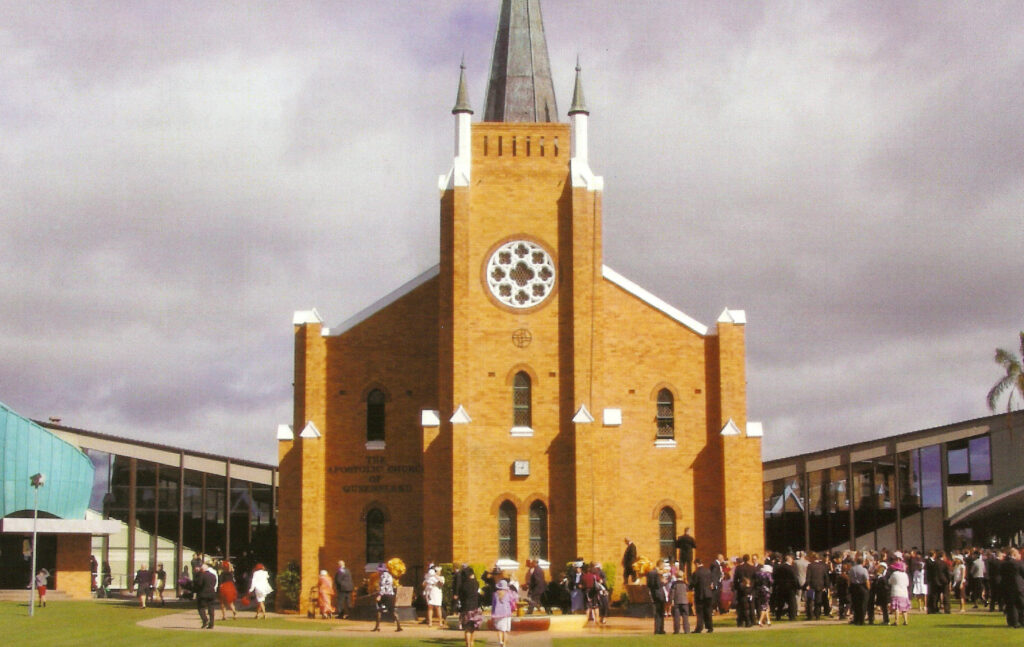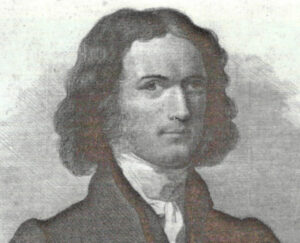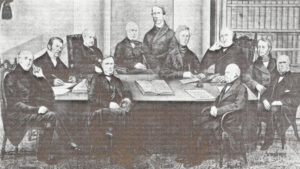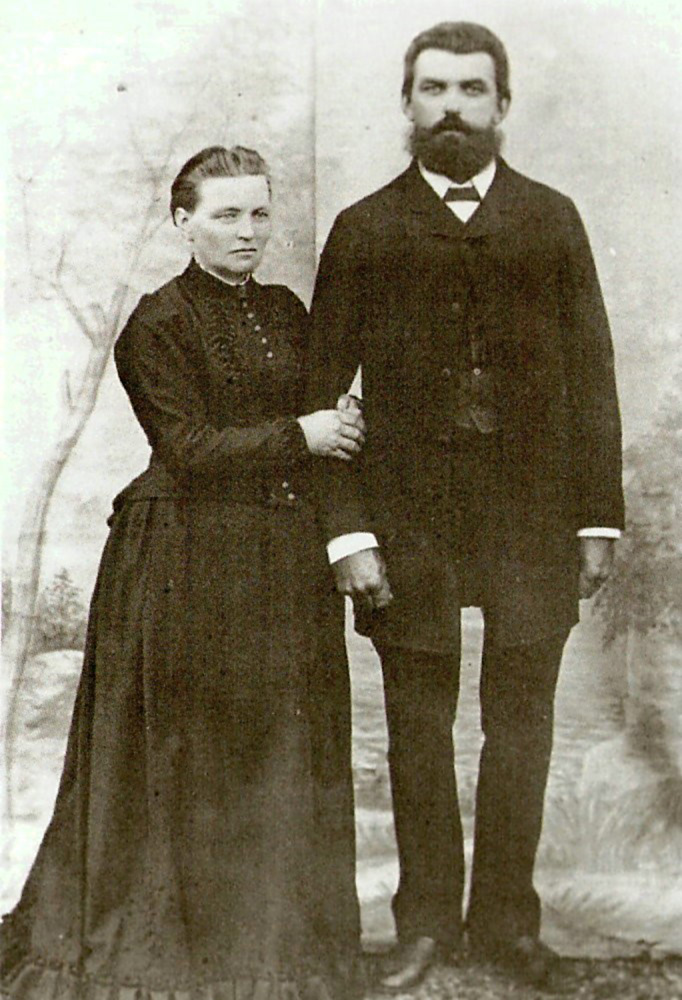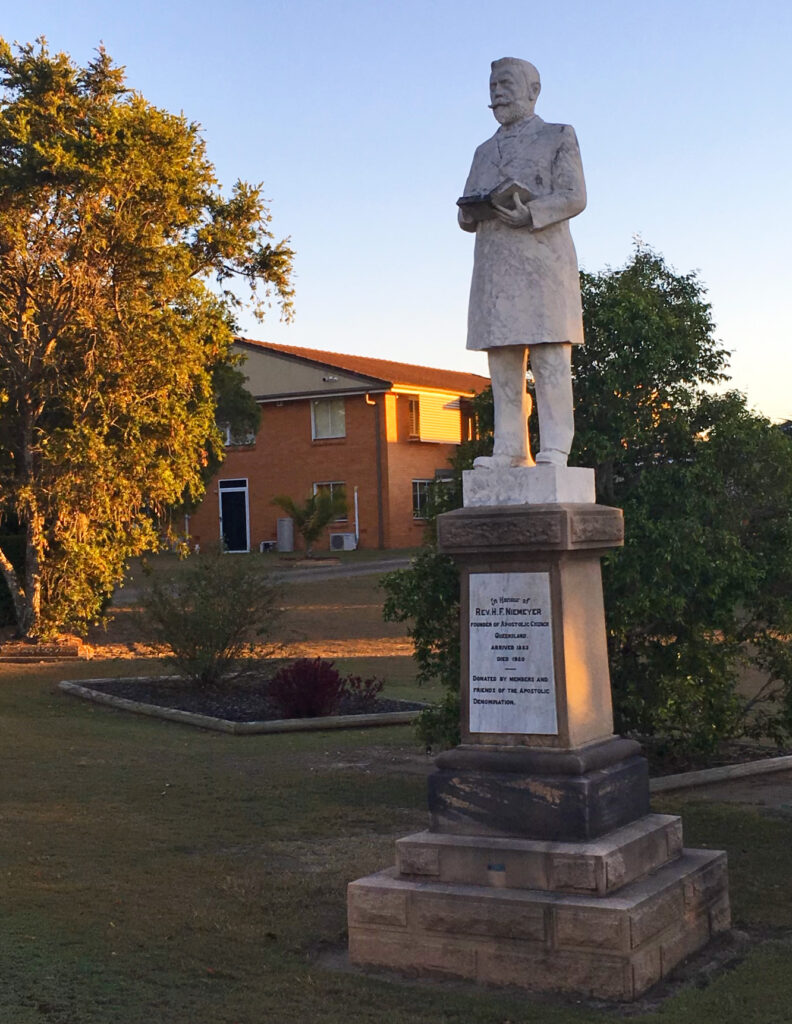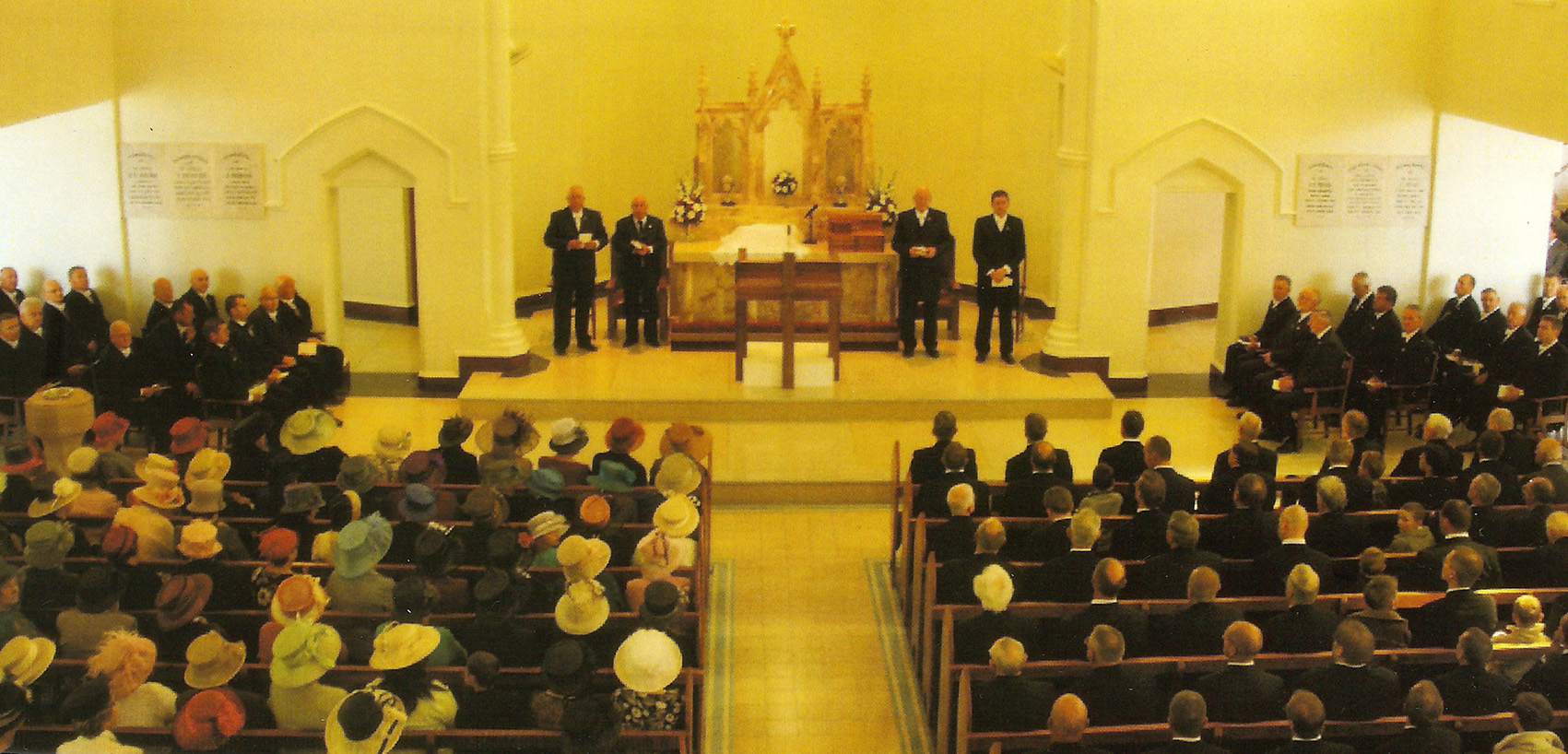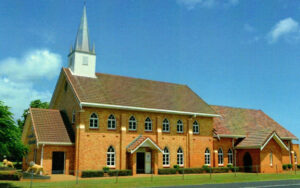Charismatic Revivalism: Tradition and innovation in the Apostolic Church
The Apostolic Church of Queensland, a small religious body transported from Germany to Australia in 1883, teaches that an outpouring of charismata in Britain in the early nineteenth century led to a restored apostolate of the Early Christian Church. The charismatic underpinnings of this restorationist leadership system were tested when one of its leaders attempted to introduce innovations in teaching.
By Charles McGrath
This is a 15 minute read, published in June 2024.
The Apostolic Church of Queensland (ACQ) is a small pre-millennial religious body which was transported from Germany to Australia in 1883. It therefore counts as one of Australia’s ethnic German churches. The ACQ, a religious body claiming charismata, has had a strong sense of tradition. Nevertheless, it has been able to accommodate innovation, though at some cost to the church community’s unity.
Origins
The ACQ is a product of its Adventist, pre-millennial and charismatic roots. Such roots sprouted during religious activism in early nineteenth century Britain in response to the alleged morbidity of the established Churches. While residing in London, the Scottish Presbyterian minister, Edward Irving, developed a system of meaning based on his interpretation of unfulfilled biblical prophecy to explain what he saw as unprecedented social, economic, and political changes that impacted on the social order of the time. His system involved a synthesis of Adventism, millennialism and charismata and, according to Irving, predicted Christ’s Second Coming and millennial reign. Irving’s restorationist approach encouraged enthusiasm for a governance system that mainstream Christianity insisted was confined to the Early Church.
Irving’s unorthodox preaching played a significant part in encouraging the outbreak of charismatic phenomena. Believing that there was no scriptural support for the withdrawal of the gifts of the Holy Spirit, he preached that the time was again ripe for the Holy Spirit to empower men with gifts (known as charismata) appropriate ‘for apostles, prophets and evangelists, discerning of spirits, speakers with tongues and interpreters of tongues’ (Drummond, 1937: 114). This reflected a current that was evident in earlier revivalist movements like the Primitive Methodists (Maddox and Vickers, 2010: 82–83). During the 1830s, followers of Irving, dubbed the ‘Irvingites’, believing they were endowed with the spiritual gift of prophecy, called for the restoration of the office of apostle as existed in the Early Church. By 1835, twelve apostles were called through the believed gift of prophecy. The apostles were drawn from the middle class and lower nobility. They comprised two Church of England ministers, a Presbyterian minister, a member of parliament, three lawyers, two aristocrats, an author, a wholesale chemist and a civil servant (Davenport, 1974: 93–95).
The Irvingite Movement (IM) believed that the Holy Spirit working through the office of apostle was the divinely appointed means of preparing adherents for membership of the Bride of Christ. This instance of charismata became an enduring feature of the IM and the various schematic bodies, including the ACQ, that trace their roots to the IM.
As a consequence of the charismatic generated belief that it was essential to salvation, the apostle office became the centrepiece of the IM’s worldview and was eventually restored with absolute authority with respect to ecclesiastical matters.
The absolute authority wielded by the apostle office turned out to be a double-edged sword because it facilitated policies that were detrimental to the future of the Catholic Apostolic Church (CAC), the institutionalised form of the IM. The IM was assigned the name ‘Catholic Apostolic Church’ for the purposes of the 1851 census. This development forced the IM to finally acknowledge that it could no longer maintain the fiction that it was not a schismatic body (Schröter, 2001: 17).
By this time, the CAC was travelling the well-worn introversionist path of religious protest groups whose claims were rejected by the dominant religious and secular institutions (Wilson, 1970: 118). Whereas the CAC’s formative mission was to unite a fractured Church under a restored apostolate, within thirty years it was calling Christ’s Elect out of it (Grass, 1997: 178). Although the CAC ensured its extinction by not replacing deceased apostles, the apostle office-centric worldview survived by dint of a mid-nineteenth century schism in Prussia to where the CAC had spread. Further schisms occurred in Prussia and it was from one of these schismatic bodies, the Allgemeine Christliche Apostolische Mission (General Christian Apostolic Mission [GCAM]) that the foundation leader of the ACQ, Heinrich Friedrich Niemeyer, emerged (Schröter, 2001: 232).
Foundation leader
The ACQ’s foundation leader, Heinrich Friedrich Niemeyer, was an economic migrant who was ordained as an evangelist of the GCAM in 1880 (Zischke, 2008). Niemeyer experienced depressed economic conditions for most of his working life in Prussia. Economic depression during the years 1873–96 resulted in large scale migration. As a railway worker, Niemeyer was hard pressed to support his family of five. While these economic push factors were operating in Prussia, there were pull factors emanating from Australia. Promotion of the colony of Queensland as a land of opportunity by the Colonial government and its emigration agent, Johann Christian Heussler, were reinforced by encouragement from Niemeyer’s brother-in-law, who had migrated to Queensland in 1865 and who was established in business in Brisbane. Almost penniless, Niemeyer disembarked from the Almora in Brisbane with his wife and three children on 28 June 1883.
Following the lead of the many German economic migrants who preceded him, Niemeyer sought to establish himself as a small freehold farmer, even though he lacked farming experience (Apostolic Unity Church, 1908: 15–16). The Niemeyers appeared destined to become just another battling immigrant family eking out a subsistence living on a debt burdened property. A near-death experience in 1884, however, changed the direction of Niemeyer’s life by rekindling his evangelistic zeal. He proclaimed that his survival from a snakebite while clearing his farm was a miracle of answered prayer (ACQ, 1933: 83–84). Believing that his near-death experience was a sign from God that he was evading his calling as an evangelist, Niemeyer shared his ‘bush miracle’ among his neighbours (Perkins and Tampke, 1986: 381), in the process spreading the GCAM doctrine.
Although having attained the position of only a railway signalman in Germany, Niemeyer now displayed considerable leadership in gathering a following. As a one-time Lutheran, Niemeyer was able to capitalise on similarities of belief. In particular, he was able to appeal to members of the Lutheran faction that were of pre-millennial persuasion (Leske, 1996: 87–89). According to Lutheran historian and pastor, F. Otto Theile, Niemeyer’s followers were attracted by the prospect of membership of God’s elect (the Bride of Christ) through the sacrament of Sealing. In an environment of hardship and privation, Niemeyer offered them the promise of belonging to a 144,000 strong elect body which would rule with Christ during the Millennium (Theile, 1938: 31).
Another important element of the meaning system offered by Niemeyer was the notion that the living could assist the deceased through the proxy partaking of the sacraments to remedy any deficiencies at the time of death (Niemeyer, 1914). This facility took away the anxiety of dying in a state of sin with its negative implications for the destiny of the soul. During an era when death during childbirth was common for settler women, this doctrine was likely a source of much comfort. This pre-tribulation doctrine promised to save Niemeyer’s followers from the Great Tribulation mentioned in the New Testament Book of The Revelation (Apostolic Unity Church, 1908: 70). Writing in 1938, Theile estimated that Niemeyer had attracted a following of 2,000 Lutherans and that efforts to entice them back into the Lutheran fold had been largely unsuccessful (Theile, 1938: 32).
Niemeyer’s success as an evangelist was rewarded by his superiors in Germany. He advised the GCAM in Germany of the results of his evangelistic efforts and requested that arrangements be made for an apostle to seal the converts (ACQ, 1933: 89). In response, the GCAM summoned Niemeyer to Germany, at Niemeyer’s expense (Niemeyer, 1911), where he was ordained as the apostle for Australia in a ceremony at Osterode, Lower Saxony, on 25 July 1886 (ACQ, 1933: 89–90).
In order to augment the communities in Australia, Niemeyer enticed GCAM members in Germany to migrate to Australia. A total of approximately 600 migrants were sponsored by Niemeyer between 1908 and 1912 (Overlack, 1984: 110–11). He settled them in rural hamlets in Central Queensland at Port of Baffle Creek, Binjour Plateau, Malmoe (Perkins and Tampke, 1986: 381), and Cedars Creek. The majority of the Cedars Creek group later resettled at Tansey when conditions at Cedars Creek proved unfavourable (Keune, 2000: 131–34). Niemeyer attributed this gathering of souls to the workings of the Holy Spirit through him (Niemeyer, 1911).
Niemeyer split with Germany in 1912 and renamed his group, Echt Apostolische Kirche [Genuine Apostolic Church] (Niemeyer, 1913: 1). A further name change to the Apostolic Church of Queensland (ACQ) took place in 1930. Shortly after, an Official Letters Patent establishing the church’s legal status was granted and subsequently amended in 1962.
In 1961 the ACQ was divided into two circuits in response to the ordination of joint apostles of equal authority (ACQ, 2000: 21). These circuits became two districts in 1990 with the installation of two independent apostles of equal authority (ACQ, 2000: 27). The Southern District comprises 12 communities south of the Brisbane River while the Northern District incorporates the 15 communities to its north. Attempts to service small groups in Sydney, Melbourne, Adelaide, and Perth are ongoing, with a desire to grow viable communities. From its inception, the ACQ serviced the spiritual and, in its formative years at least, social needs of German immigrants. Its current membership is predominately comprised of the descendants of Lutherans proselytised by Niemeyer and the migrants sponsored by Niemeyer between 1908 and 1912. In 1995 the ACQ claimed a membership of 6,000 (Ward and Humphreys, 1995: 163).
Innovations
The charismata charged, apostle-centric world view of the ACQ remained intact until early 1970. At that time, the Northern District (ND) apostle voiced his concern that the ACQ was focussing on converting people to an apostle more than to Christ, resulting in an apostle being given pre-eminence over Christ (Zielke, 1977).
The ND apostle’s concerns appeared to be centred on the means of becoming a member of the Bride of Christ. ACQ teaching was that only those sealed by the laying on of hands of a living apostle, and prepared for the Second Advent by the Holy Spirit working through the apostle office, could become members of the Bride of Christ. Instead, he proposed that the Bride of Christ constituted the martyrs, mentioned in Revelation 20:4, who would witness Christ during the Great Tribulation (ACQ, 1984).
In addition, in lieu of the ACQ’s pre-tribulationist doctrine, which claimed that sealed adherents would avoid the persecution of the Great Tribulation by taking part in the First Resurrection, the ND apostle was now proposing a post-tribulationist doctrine that required adherents to experience the Great Tribulation along with everyone else so as to earn their membership of the Bride of Christ by becoming martyrs for Christ.
The ND apostle further rejected the ACQ’s doctrine that the Holy Spirit could only be received by the laying on of hands of a living apostle. He argued that it could be received in other ways, in reference presumably to the Spirit baptism of the household of Cornelius in Acts 10:44, which did not involve the laying on of hands of a living apostle (ACQ, 1984). In addition, he refuted the teaching that only sealed Apostolics could belong to the Bride of Christ and that all other Christians would be accommodated in the many heavenly mansions. Instead, the ND apostle argued that all Christians had the opportunity to belong to the Bride of Christ which, he contended, included martyrs for Christ, the ones who have not received the mark of the beast (ACQ, 1984). Further, he dismissed the teaching that the living could in any way help to redeem departed souls through the proxy partaking of the sacraments (ACQ, 1984).
The ND apostle summed up by asserting that it was wrong for the ACQ to claim exclusive rights to salvation (ACQ, 1984).
For those members of the ACQ with a propensity for dependence, these innovations were an unsettling development. Historically, because they believed it was the role of the apostle office to prepare them to become members of the Bride of Christ, independent thinking was not considered necessary, nor was it encouraged. Indeed, it was positively discouraged through warnings in the ACQ Catechism that to challenge a teaching bordered on blaspheming the Holy Spirit, because it was thought to be inspired by the Holy Spirit, a sin with potentially dire consequences for the welfare of the soul (ACQ, 1967: 55).
This dependency was unsurprisingly more prevalent among the older members who, because they had limited exposure to competing meaning systems, were thoroughly socialised to accept the indispensability of the apostle office for their salvation. For many of the younger ministers and members, whose education encouraged independent thought and exposed them to the ideology of individualism, the ND apostle’s innovations were more welcome.
Predictably, such a significant departure from long held beliefs did not go unchallenged. The Southern District (SD) apostle rejected them out of hand. By this time, the teachings of past apostles had come to be taken for granted; they offered stability in an ever-changing world. According to Joachim Wach ‘the guardian of the sacred tradition commands the greatest respect of his people’ (Wach, 1962: 335). Such traditions, according to Wach, include special functions that can only be fulfilled by venerated religious leaders (Wach, 1962: 336). His observations are particularly relevant to the ACQ because of its belief that the apostle office was the only ordinance approved by Christ to lead His Church. Accordingly, the apostle office was believed to have an intercessory function as the channel through which the Holy Spirit worked to dispense God’s blessings to adherents (ACQ, 1967: 50, 56).
The SD apostle vigorously defended the traditional teaching. He emphasised that Christ had given the power of the keys only to his apostles and therefore no other Christians could be forgiven their sins. All other Christians would be awarded a place in the many heavenly mansions on Judgement Day according to their faith and works but Christ was preparing a special place for His Bride through a restored apostolate (ACQ, 1988).
Meredith McGuire makes the point that it often requires deviance to usher in a new worldview. According to McGuire, the leader does so by ‘conveying to the followers a sense of crisis, then offering a solution to the crisis — a new normative order’ (McGuire, 2002: 252). The ND apostle’s dilemma was that he was not able to create a sense of crisis with a majority of the ministry and members of the ACQ. They were not interested in fixing something that they did not consider to be broken.
Unintended consequences of innovation
Many ministers and members found it difficult to understand how the one office of apostle, which was supposedly inspired by the one Holy Spirit, produced such disharmony between their joint apostles. The resulting confusion led to significant instability within the ACQ.
The total leakage from the instability up until January 1986, by which time the Southern and Northern Districts had developed into traditional and evangelical enclaves, was 3 deacons and approximately 150 members (ACQ, 1986). Many of these members joined other Christian churches.
The members who remained in the Northern District fell largely into three groups. Such groups comprised: those who disagreed with the ND apostle’s new teachings and were planning relocation to the Southern District; those who disagreed with the ND apostle but stayed in the Northern District because their investment in the ACQ was in their sense of belonging rather than in its doctrine; and those who supported the ND apostle’s evangelical teaching. Given that most of the members were born into the ACQ and that its lay priesthood and deaconate was ordained for specific communities only, strong social networks existed between the ministry and the members as well as among the members, which contributed to a sense of belonging.
An important element in the maintenance of a sense of community and belonging was the ACQ’s festival system of worship, where the calendar year is divided ecclesiastically around the various aspects of Jesus Christ’s work on earth. Up until the mid-1970s, a festival gathering involved a communal meal often including German sausage, plum jam, and white bread. During the meal the members were entertained by a church band. Although the menu is no longer German, the festival program continues in its traditional form. This strong sense of community helped to minimise the number of defections, reflecting Meredith McGuire’s observations that a sense of belonging often took precedence over beliefs in religious group participation (McGuire, 2002: 292).
At the present time, the apostles of the Southern and Northern Districts have agreed to disagree about changes to traditional teaching and to acknowledge the independence of each district.
The Southern District sees virtue in its traditional exclusive teaching based on the notion that such traditions are the commandments of God as made known to the apostle office through the Holy Spirit. Accordingly, they believe that meddling with such divinely inspired traditions risks a rending of the very fabric of the ACQ’s worldview.
Meanwhile, the Northern District has continued the practice of retaining only those traditions that are endorsed by scripture as it continues to refine its purpose within Christo-centric Christianity. As part of this process, it has increased its charitable activities and returned to a strong mission emphasis. This mission emphasis has resulted in the establishment of sister churches in New Zealand, the Philippines, India, Pakistan, Kenya, Myanmar, Canada, and Ukraine. Both apostles appear to believe that the charismata underpinnings of their respective apostle offices remain intact and that the disagreements between the two Districts are biblically condoned in 1 Corinthians 12:5 as differences in administration.
However, the agreement to disagree over direction has not come without costs.
The escalation of these differences over a period of fifty years has resulted in a de facto schism. The lack of joint district activities since the adoption of the organisational structure of independent traditionalist and evangelical districts in 1990 has fostered the development of different cultures, fewer inter-district marriages, and less extensive family ties between the two districts.
To their credit, the apostles of the Southern and Northern Districts have disagreed respectfully. Ministers and members who visit communities not in their district are welcomed by the host community and afforded the blessings available. For their part, the visitors are mindful of respecting the differences in administration between the two Districts.
Sources and further reading
(ACQ — Apostolic Church of Queensland)
ACQ. 1933. The 50th Jubilee of the Apostolic Church in Queensland. Brisbane: ACQ.
ACQ. 1967. A Review of 83 Years of Labour. Capalaba: ACQ.
ACQ. 1984. ‘Minutes of Meeting of Ministers,’ 1 January 1984.
ACQ. 1986. ‘Minutes of Meeting of Ministers,’ 1 January 1986.
ACQ. 1988. ‘Minutes of Meeting of Ministers,’ 1 January 1988.
ACQ — Southern District. 2000. History of the Apostolic Church of Queensland, Southern District: From Foundation to the Year 2000. Capalaba: ACQ — Southern District.
Apostolic Unity Church. 1908.The 25th Jubilee of the Apostolic Unity Church in Queensland. Translated by A. Putzke. Brisbane: Apostolic Unity Church.
Davenport, R. A. 1974. Albury Apostles: The Story of the Body Known as the Catholic Apostolic Church (Sometimes Called ‘Irvingites’). London: Neillgo Publications.
Drummond, A. L. 1937. Edward Irving and His Circle Including Some Consideration of the ‘Tongues’ Movement in the Light of Modern Psychology. Carter Lane: James Clarke.
Grass, T. G. 1997. ‘The Church’s Ruin and Restoration: The Development of Ecclesiology in the Plymouth Brethren and the Catholic Apostolic Church, c.1825–c.1866.’ PhD thesis, King’s College London.
Keune, L. 2000. ‘The German Settlement at Tansey,’ in Neverending Stories: A Tribute to Our Pioneers, ed. Judith Bandidt, (Goomeri: Goomeri Writers Group).
Leske, E. 1996. For Faith and Freedom: The Story of Lutherans and Lutheranism in Australia, 1838-1996. Adelaide: Openbook Publishers.
Maddox, R. K. and J. E. Vickers, eds. 2010. The Cambridge Companion to John Wesley (Cambridge: Cambridge University Press.
McGuire, M. B. 2002. Religion: The Social Context, 5th edn. Belmont, CA: Wadsworth.
Niemeyer, H. F. 1911. ‘Circuar.’ Translated by R. Albrecht, 21 February 1911.
Niemeyer, H. F. 1913. Public Appeal to Apostolics All Over the World. Translated by B. Leisemann. Wernigerode: Genuine Apostolic Church.
Niemeyer, H. F. 1914. ‘Good Friday Pastoral Letter.’ Translated by B. Sickinger, 10 April 1914.
Overlack, P. 1984. ‘German Settlers in the Moreton Bay Region, 1838-1914.’ Journal of the Royal Historical Society of Queensland 12, 1: 103–18.
Perkins, J and J. Tampke. 1986. ‘Two Pastors and Their Flocks: An Episode in the European Settlement of Queensland.’ Journal of the Royal Historical Society of Queensland 12, 5: 379–87.
Schröter, J. A. 2001. Images of the History of the Catholic Apostolic Church. Jena: Christine Jager.
Theile, F. O. 1938. One Hundred Years of the Lutheran Church in Queensland. Brisbane: Watson Ferguson.
Wach, J. 1962. Sociology of Religion. Chicago: University of Chicago Press.
Ward, R. and R. Humphreys. 1995. Religious Bodies in Australia: A Comprehensive Guide. 3rd ed. Wantirna: New Melbourne Press.
Wilson, B. R. 1970. Religious Sects: A Sociological Study. London: Weidenfeld & Nicolson.
Zielke, A.E. 1977. ‘Letter to J. Burton.’ 25 January 1977.
Zischke, Cheryl. 2008. ‘Niemeyer Family History.’ August 2008.
Related articles


